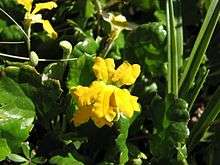Goodenia hederacea
Goodenia hederacea, the ivy goodenia or forest goodenia,is a flowering plant that is endemic to Australia. It may be prostrate or grow up to 80 cm (31 in) in height with stems arising from the base.[1] Leaves are 10 to 120 mm long and 3 to 25 mm wide with a green upper surface, and a lower surface which may be hairless or tomentose. The yellow flowers are 8 to 15 mm long and appear between August and April in the species' native range.[1] The species occurs in alpine woodland, forest and grassland in ranges and coastal areas of Queensland, New South Wales and Victoria.[1]
| Goodenia hederacea | |
|---|---|
 | |
| Goodenia hederacea subsp. alpestris at Mount Skene, Victoria | |
| Scientific classification | |
| Kingdom: | Plantae |
| Clade: | Tracheophytes |
| Clade: | Angiosperms |
| Clade: | Eudicots |
| Clade: | Asterids |
| Order: | Asterales |
| Family: | Goodeniaceae |
| Genus: | Goodenia |
| Species: | G. hederacea |
| Binomial name | |
| Goodenia hederacea | |
The species was first formally described by English botanist James Edward Smith in 1794 in Transactions of the Linnean Society of London [2]
Two subspecies are currently recognised:[2]
- Goodenia hederacea subsp. alpestris (K.Krause) Carolin
- Goodenia hederacea Sm. subsp. hederacea
In cultivation, the species prefers a situation in part shade and with some moisture. It copes with a range of soil types and tolerates frost and snow.[3]
References
- "Goodenia hederacea". PlantNET - New South Wales Flora Online. Royal Botanic Gardens & Domain Trust, Sydney Australia. Retrieved 10 January 2010.
- "Goodenia hederacea". Australian Plant Name Index (APNI), IBIS database. Centre for Plant Biodiversity Research, Australian Government, Canberra. Retrieved 10 January 2010.
- Greig, D. (1987). The Australian Gardener's Wildflower Catalogue. Australia: Angus & Robertson. ISBN 0207154600.
External links
- Image of seed: Goodenia hederacea. Australian Plant Image Index, Australian National Botanic Gardens, Australian National Herbarium.